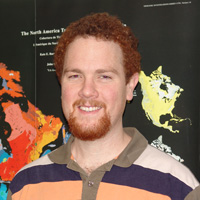 Andrew GritzEffect of Heterogeneous Prestress on Near-Field Rupture Directivity M.S. Candidate Monday, March 9th, 2009 |
||
|
||
|
To supplement the very limited number of strong motion recordings in areas near to earthquake sources, numerical modeling of the rupture process and radiated seismic energy was carried out to study such ground motion. The near fault region is susceptible to very strong shaking both because of proximity to the fault and directivity effects, but may also be sensitive to particulars of the rupture process including effects of heterogeneity on the coherence of the rupture. Stochastic realizations of initial stresses on the fault plane with varying values of roughness, combined with a depth-dependent normal stress, are used in numerical simulations of large strike-slip earthquakes to examine how such heterogeneities influence the near-field directivity effects. The resulting synthetic earthquakes have predominantly unilateral rupture propagation with varying degrees of rupture coherence. Response spectra of the synthetic acceleration records at the free surface are analyzed by a method analogous to that used to develop empirical ground motion relations. The dependence of the response spectral shapes on hypocentral distance reflects, in some cases, a roughly self-similar initial rupture growth. The result is complex behavior of response spectral amplitude as a function of along-strike distance at smaller periods, but clearer directivity (along-strike enhancement) at periods of 2 seconds and above. Also present in many cases is a saturation in the trend of along-strike enhancement of the response spectra values when hypocentral distance exceeds some threshold. At periods of 2 seconds and larger, results of an analysis of directivity match reasonably well with earlier empirical studies, while at a period of 1 second, little directivity is observed, in agreement with recent empirical predictions. The stochastic heterogeneities have mixed effects on directivity, but at larger periods there is systematic increase in directivity effects with increasing roughness. However, more important than this heterogeneity, appears to be the underlying depth dependence of the normal stress. To quantify the observed saturation in directivity effects, data from the simulations is fit to a model capping such effects, and values of the predictor value at which this saturation occurs generally agree with empirical and numerical predictions for large strike-slip faults. The value of the predictor variable at which this saturation occurs, changes when the fault length is extended, and an alternative predictor variable is much better able to track this saturation. |

